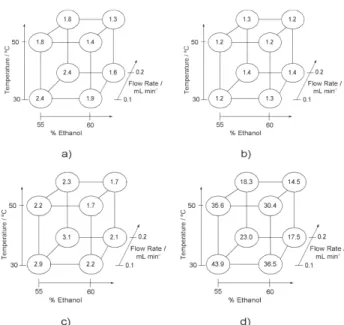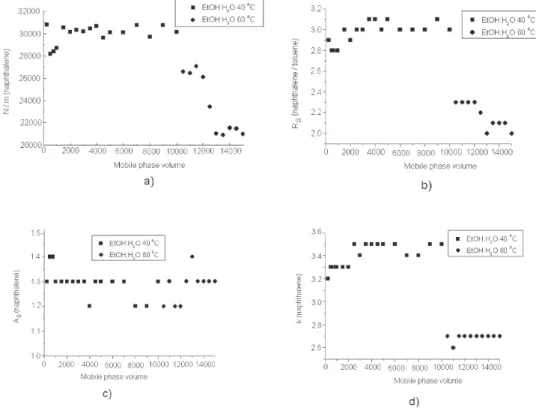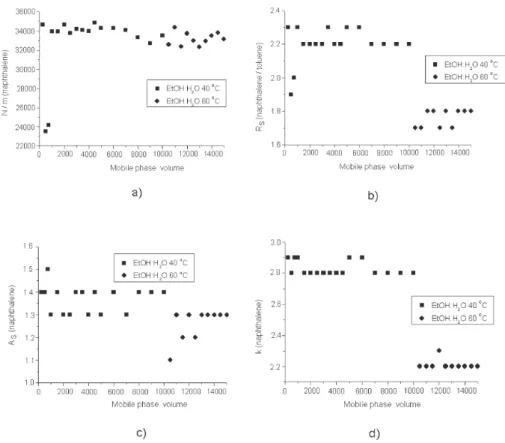0103 - 5053 $6.00+0.00
Article
* e-mail: chc@iqm.unicamp.br
Reevaluation of Ethanol as Organic Modifier for Use in HPLC-RP Mobile Phases
Ricardo L. V. Ribeiro, Carla B. G. Bottoli, Kenneth E. Collins and Carol H. Collins*
Instituto de Química, Universidade Estadual de Campinas, CP 6154, 13083-970 Campinas - SP, Brazil
Misturas de etanol:água foram reavaliadas para uso como fases móveis para Cromatografia Líquida de Alta Eficiência no modo fase reversa (CLAE-FR). A otimização das condições cromatográficas para as colunas C8 e C18 foram realizadas através de um planejamento fatorial o qual avaliou temperatura, concentração de etanol e vazão da fase móvel. Com a fase estacionária C8, as assimetrias dos picos não alteraram nos diferentes pontos do fatorial, enquanto os fatores de retenção e as resoluções diminuíram com o aumento da temperatura, na qual a viscosidade do etanol é mais baixa. Observações similares foram obtidas com a fase estacionária C18. A eficiência cromatográfica obtida com a fase móvel etanol:água na separação de misturas contendo compostos neutros e básicos foi comparada com aquelas obtidas usando fases móveis de metanol:água e acetonitrila:água. O etanol mostrou ser um bom modificador orgânico para CLAE-FR apresentando boas propriedades cromatográficas. Assim, considerando a menor toxicidade do etanol, a facilidade do seu descarte e seu custo favorável, etanol:água pode ser uma das escolhas de fase móvel para as diversas aplicações de CLAE-FR.
Ethanol:water mixtures have been reevaluated for use as reversed phase mobile phases. Optimization of the chromatographic conditions for both C8 and C18 columns was carried out through a factorial design which evaluates temperature, ethanol concentration and mobile phase flow rate. With the C8 stationary phase, peak asymmetries were not significantly altered at the different points in the factorial design while the retention factors and resolutions were somewhat lower at higher temperatures, where the viscosity of EtOH is lower. Similar observations were obtained with the C18 phase. The efficiency of the ethanol:water mobile phase for the separation of mixtures containing neutral and basic compounds was compared with those obtained using methanol:water and acetonitrile:water mobile phases. Ethanol was shown to be a good organic modifier for RP-HPLC, with good chromatographic properties. This, considering the much lower toxicity of ethanol, the facility of its disposal, and its favorable cost, should make ethanol:H2O the mobile phase of choice for many RP-HPLC applications.
Keywords: HPLC, mobile phase, ethanol, methanol, acetonitrile
Introduction
The most widely used technique of High Performance Liquid Chromatography (HPLC) is the reversed-phase (RP) mode, in which the mobile phase is more polar than the stationary phase.1 At present approximately 90% of all
HPLC separations are carried out by HPLC-RP.2 The mobile
phases most frequently used in RP-HPLC consist of
solutions of methanol:water (MeOH:H2O) or
acetonitrile:water (ACN:H2O).3 This is so despite the fact
that both these mobile phases are quite toxic. Thus, disposal of either of these mobile phases requires special treatment steps, especially for acetonitrile, which has to
be detoxified through chemical treatment since the easier (combustion) route produces highly toxic HCN.4 It is
obvious that reduction of the amount of organic solvents is the most advantageous approach to waste management. All wastes obtained in a laboratory need careful recycling or disposal. However, generation of some mobile phase waste is inevitable. Thus, if other factors are about the same, the much lower toxicity of ethanol and the facility of its disposal, should make ethanol:water the mobile phase of choice for many RP-HPLC applications.
Methanol and acetonitrile have many properties favorable for RP-HPLC applications. Among these are complete miscibility with H2O, excellent UV transmission
(above λ = 195 nm for acetonitrile and 205 nm for
methanol),3 relatively low viscosity aqueous solutions,3
chemical reactivity with most sample species as well as with HPLC instrument and column surfaces.
However, methanol and acetonitrile also have important disadvantages: high toxicity as liquid or vapor,5 high
volatility, which tends to alter the mobile phase composition upon storage and high to very high disposal costs.
Ethanol shares most of the favorable characteristics of methanol and acetonitrile for RP-HPLC use but also has two characteristics that are less favorable. One of them is that the viscosities of ethanol:H2O solutions are higher than those of MeOH:H2O and ACN:H2O solutions of the same elution strength at room temperature. Thus, the corresponding pressure required for a typical
chroma-tographic separation tends to be higher.3 The other
characteristic is that in the United States of America, where many HPLC procedures are developed, and other countries which also have ethanol control regulations, the routine use of this solvent is complicated.
Ethanol was used as an organic modifier in the early days of HPLC, due to its higher purity at that time.6 However,
it was substituted by methanol and acetonitrile, as their
purities were improved. Recently, Miyabe et al.7
reinvestigated the influence of the type of organic modifier in the mobile phase and found that, although the characteristics of the three mobile phase solvents investigated (methanol, acetonitrile and ethanol) were not identical, the reversed phase separation mechanisms were, in fact, quite similar for each of the three systems.
Similarly, Ribeiro et al. have shown the potential of ethanol:water as a mobile phase with a C18 reversed phase for chromatographic separation of neutral compounds.8
In the present work we evaluate the several factors involved in the possible routine use of EtOH:H2O for RP-HPLC applications by direct comparisons with MeOH:H2O
and ACN:H2O mobile phases for typical RP-HPLC test
separations.
Experimental
Chromatograms were obtained on a Waters system consisting of two Model 510 pumps, a Model 911 detector, used at 254 nm, and a Model CHM oven with a Model TCM temperature controller. A Rheodyne Model 8125 (10 µL) injector was used. Columns (150 x 3.8 mm i.d.) were slurry packed using 20% slurries (m/v) in carbon tetrachloride of C18 (Rainin PK201, spherical, 5 µm,
10 nm) or C8 (Rainin PK301, spherical, 5 µm, 10 nm)
stationary phases. Packing pressures of 37 MPa for C18 and 48 MPa for C8 (Haskel packing pump) were used, with methanol as propulsion solvent. Ethanol, methanol
and acetonitrile (Merck) were of HPLC grade and water was distilled and deionized (Milli-Q).
Factorial planning was employed to optimize the chromatographic separation of a neutral test mixture containing acetone, benzonitrile, benzene, toluene and naphthalene using each mobile phase. The factors and levels for a 23 factorial are given in Table 1. Results were
calculated by the FACTORIAL program.9,10
To simulate usual chromatographic practice, the columns were subjected to stability testing by washing the stationary phases at a flow rate of 0.8 mL min-1 to
10000 mobile phase volumes at 40 °C and then to 15000 mobile phase volumes at 60 °C. During this program, tests
were periodically performed (at 0.2 mL min-1) using
60:40 v/v ethanol:water for the C18 column and 55:45 v/v ethanol:water for the C8 columns. The mobile phase volume, VM, was calculated using the equation:
VM = tM × F
where tM is the retention time of an unretained compound (uracil) and F is the flow rate of the mobile phase.
For these studies, efficiency (plates per meter), retention factor (k), asymmetry (AS) and retention time (tR) were calculated from the naphthalene peak while resolution (RS) was calculated for the toluene/naphthalene pair.
A basic mixture, aniline and N,N-dimethylaniline, was tested with a 70:30 v/v EtOH:H2O mobile phase on both the C8 and C18 columns at 0.2 mL min-1 at 25 °C and at
40 °C. This basic test mixture was also tested with 85:15 v/v methanol:water and 80:20 v/v acetonitrile:water at 25 °C, solution concentrations which show similar eluotropic strength.6 The chromatographic parameters were calculated
for both peaks.
Results and Discussion
Figure 1 shows the results obtained with the 23 factorial
design (Table 1), using the C8 column. All separations were carried out in duplicate and the average values are shown. With the C8 stationary phase, both resolution and asymmetry were not significantly different at the different points in the
Table 1. Factors and levels utilized in the 23 factorial design
Factor Level (C18 column) Level (C8 column) ( – ) ( + ) ( – ) ( + )
1: temperature (oC) 3 0 5 0 3 0 5 0
2: % ethanol 6 0 7 0 5 5 6 0
factorial design while the retention factor and retention time were lower at the higher temperature, where the mobile phase viscosity is lower. Similar results are observed with a C18 column, as can been seen in Figure 2.
Considering the results of this experiment design, optimal conditions for chromatographic separations using the C8 column are: 55:45 v/v EtOH: H2O at 50 oC with a 0.2 mL min-1
flow rate. Figure 3a shows a chromatogram obtained with these conditions. A similar separation was obtained with the C18 column using similar conditions (Figure 3b) where, because of the different characteristics of the C18 phase, the resolution of the toluene-naphthalene pair is better.
With optimized conditions of the ethanol:water mobile phase, mobile phases of the same eluotropic strength with
methanol:water and acetonitrile:water were tested.6 The
flow rates were optimized by means of a van Deemter curve. The compositions and flow rates of each mobile phase are given in the Table 2. Thus, the chromatographic efficiency using ethanol as organic modifier at 25 °C is the same as when methanol is used, supporting earlier observations7,8
that ethanol can substitute methanol without affecting the separation efficiency. When the temperature was increased from 25 °C to 40 °C, to decrease the viscosity of ethanol:H2O mobile phase,3 the efficiency decreased
slightly but was still similar to that obtained with the acetonitrile:H2O phase.
Another form of evaluating the viability of the use of ethanol as organic modifier is through stability testing.
Figure 2. Results of the 23 factorial design with the C18 column: a)
resolution, b) asymmetry, c) retention factor and d) retention time.
Figure 1. Results of the 23 factorial design with the C8 column: a)
resolution, b) asymmetry, c) retention factor and d) retention time.
Figure 3. Chromatograms obtained with the a) C8 column and b) C18 column. Mobile phase: 55:45 v/v EtOH:H2O for C8 column and 60:40 v/v EtOH:H2O for C18 column. F = 0.2 mL min-1. Column temperature: 50 oC. Peak identification: 1: acetone; 2: benzonitrile; 3: benzene; 4:
Figure 4. Stability evaluation of C18 column in terms of (a) efficiency, (b) resolution, (c) asymmetry and (d) retention factor. Test conditions: mobile phase: 60:40 v/v ethanol:water, flow-rate: 0.8 mL min-1, sample: naphthalene. Chromatographic conditions: mobile phase: 60:40 v/v
ethanol:water, flow-rate: 0.2 mL min-1.
Table 2. Composition and optimized flow-rates for all mobile phases
Column Mobile phase Temperature (°C) Composition (v/v) F (mL min-1) N/La
C8 EtOH:H2O 2 5 55:45 0.20 36000
EtOH:H2O 4 0 55:45 0.20 32300
MeOH:H2O 2 5 66:34 0.35 35700
ACN:H2O 2 5 64:36 0.30 30700
C18 EtOH:H2O 2 5 60:40 0.15 32100
EtOH:H2O 4 0 60:40 0.25 29500
MeOH:H2O 2 5 72:28 0.35 32300
ACN:H2O 2 5 70:30 0.30 27300
a calculated for naphthalene.
For a C18 column, up to 10000 volumes of mobile phase were passed through at 40 °C without altering the column efficiency. A significant decrease occurred when the temperature was increased to 60 °C (see Figure 4). However, the asymmetry factor was practically unchanged at both 40 and 60 °C. Thus, the chromatograms showed good separations of the peaks even after the passage of 10000 times the mobile phase volume of the column (about 10 liters).
The results of the stability test using a C8 column are summarized in Figure 5. For this column, the efficiency remained stable up to 10000 volumes of mobile phase at 40 °C and after an additional 5000 column volumes at 60 °C. The asymmetry factor also remained constant, for both 40 °C and 60 °C. Significant decreases of resolution
and retention factor occurred only after the temperature was changed from 40 °C to 60 °C. However, the chroma-tograms did not present any significant change in peak separation.
Figure 6. Chromatograms obtained with the C18 column for separation of basic compounds using 70:30 v/v EtOH:H2O at 25 oC (a), 70:30 v/v
EtOH:H2O at 40 oC (b), 85:15 v/v MeOH:H
2O at 25 ºC (c) and 80:20 v/v ACN:H2O at 25 ºC (d). F = 0.2 mL min
-1. Peak identification: (1) aniline;
(2) N,N-dimethylaniline.
Figure 5. Stability evaluation of C8 column in terms of (a) efficiency, (b) resolution, (c) asymmetry and (d) retention factor. Test conditions: mobile phase: 55:45 v/v ethanol:water, flow-rate: 0.8 mL min-1, sample: naphthalene. Chromatographic conditions: mobile phase: 55:45 v/v
Table 3. Results of the separation of a basic test mixturea
Column Mobile phase Temperature (°C) N/Lb N/Lc R S
b c A
S
b A
S
c kb kc t
R (min)
b t
R (min) c
C8 EtOH:H2O 2 5 16300 27200 5.6 1.6 1.5 0.3 0.9 7.0 10.2
EtOH:H2O 4 0 18800 26200 4.9 1.5 1.7 0.2 0.7 6.8 9.5
MeOH:H2O 2 5 7900 23500 3.4 1.0 1.6 0.2 0.6 7.0 9.5
ACN:H2O 2 5 18100 25300 4.5 1.5 1.3 0.3 0.8 6.9 9.5
C18 EtOH:H2O 2 5 16400 25100 7.8 1.6 1.7 0.2 0.8 6.6 11.6
EtOH:H2O 4 0 15700 23500 7.0 1.5 1.6 0.2 0.8 6.4 10.9
MeOH:H2O 2 5 6800 18300 4.8 0.9 1.7 0.2 1.0 6.6 10.6
ACN:H2O 2 5 14800 21300 5.5 1.3 1.3 0.2 0.8 6.5 10.0
a Chromatographic conditions: Mobile phase:70:30 v/v EtOH:H
2O; 85:15 v/v MeOH:H2O; 80:20 v/v ACN:H2O, F=0.2 mL min
-1.b aniline. c
N,N-dimethylaniline.
Figure 7. Chromatograms obtained with the C8 column for separation of basic compounds using 70:30 v/v EtOH:H2O at 25 oC (a), 70:30 v/v
EtOH:H2O at 40 oC (b), 85:15 v/v MeOH:H
2O at 25 ºC (c) and 80:20 v/v ACN:H2O at 25 ºC (d). F = 0.2 mL min
-1. Peak identification: (1) aniline;
(2) N,N-dimethylaniline.
slightly higher than those observed with methanol:H2O. The asymmetry factors for N,N-dimethylaniline were equal for all three mobile phase modifiers.
Conclusions
This work confirms that an ethanol:H2O mobile phase is chromatographically very similar to the more usual methanol:H2O and acetonitrile:H2O mobile phases for use in RP-HPLC applications. Thus, since methanol and acetonitrile are more toxic than ethanol and acetonitrile
also presents significant disposal problems, ethanol:water mobile phases should be seriously considered as replacements for either of these mobile phases, at least in those countries where ethanol acquisition and use is feasible.
Acknowledgements
References
1. Majors, R. E.; LC-GC 1994, 12, 508.
2. Claessens, H. A.; Trends Anal. Chem.2001, 20, 563. 3. Sadek, P. C.; The HPLC Solvent Guide, Wiley: New York,
1996.
4. Gilomen, K.; Stauffer, H.P.; Meyer, V. R.; Chromatographia 1995, 41, 488.
5. Bretherick, I.; Hazards in the Chemical Laboratory, 4th ed.,
Royal Society of Chemistry: London, 1986.
6. Snyder, L. R.; Kirkland, J. J.; Introduction to Modern Liquid Chromatography, 2th ed., Wiley: New York, 1979.
7. Miyabe, K.; Takeuchi, S. A.; Tezuka, Y.; Adsorption1999, 5, 15.
8. Ribeiro, R. L. V.; Grespan, C. B.; Collins, C. H.; Collins, K. E.; Bruns, R. E.; J. High Resolut. Chromatogr. 1999, 22, 52. 9. Neto, B. B.; Scarmínio, I. S.; Bruns, R. E.; Planejamento e
Otimização de Experimentos, Editora da Unicamp: Campinas, 1996.
10. Box, G. E. P.; Hunter, W. G.; Hunter, J. S.; Statistics for Experimenters, Wiley: New York, 1978.
Received: October 18, 2002
Published on the web: April 2, 2004




